Design of High-Gain Linear Polarized Fabry–Perot Antenna Based on Minkowski Fractal Structure
Abstract
1. Introduction
2. Materials and Methods
2.1. Design of the Fractal Antenna Unit
2.2. 1–4 Power Divider
2.3. Design of Metasurface Units Based on Fractal Structure
3. Results and Discussion
3.1. Parameter Analysis of the Array Antenna
3.2. Antenna Without/with Metamaterial Superstrate
3.3. Processing and Testing of Array Antennas
4. Conclusions
Author Contributions
Funding
Data Availability Statement
Conflicts of Interest
References
- Wong, H.; Luk, K.M.; Chan, C.H.; Xue, Q.; So, K.K.; Lai, H.W. Small Antennas in Wireless Communications. Proc. IEEE 2012, 100, 2109–2121. [Google Scholar] [CrossRef]
- Mietzner, J.; Schober, R.; Lampe, L.; Gerstacker, W.; Hoeher, P. Multiple-Antenna Techniques for Wireless Communications—A Comprehensive Literature Survey. IEEE Commun. Surv. Tutor. 2009, 11, 87–105. [Google Scholar] [CrossRef]
- Chakraborty, U. A Comact Microstrip Patch Antenna for Wireless Communication. Prog. Electromagn. Res. C 2011, 18, 211–220. [Google Scholar] [CrossRef]
- Gianvittorio, J.P.; Rahmat-Samii, Y. Fractal Antennas: A Novel Antenna Miniaturization Technique, and Applications. IEEE Antennas Propag. Mag. 2002, 44, 20–36. [Google Scholar] [CrossRef]
- Oraizi, H.; Hedayati, S. Miniaturization of Microstrip Antennas by the Novel Application of the Giuseppe Peano Fractal Geometries. IEEE Trans. Antennas Propag. 2012, 60, 3559–3567. [Google Scholar] [CrossRef]
- Patel, S.K.; Baz, A. O-Shape Fractal Antenna Optimized Design with Broad Bandwidth and High Gain for 6G Mobile Communication Devices. Fractal Fract. 2024, 8, 17. [Google Scholar] [CrossRef]
- Vallappil, A.K.; Khawaja, B.A.; Rahim, M.K.A.; Uzair, M.; Jamil, M.; Awais, Q. Minkowski–Sierpinski Fractal Structure-Inspired 2 × 2 Antenna Array for Use in Next-Generation Wireless Systems. Fractal Fract. 2023, 7, 158. [Google Scholar] [CrossRef]
- Yaminisasi, G.; Pardhasaradhi, P.; Prasad, N.; Madhav, B.T.P.; Algarni, A.D.; Das, S.; El Ghzaoui, M. Fish-Tail Structured Fractal Monopole Printed Antenna with Dual Broadband Characteristics for Sub–6 GHz 5G and X–Band Radar Applications. Fractal Fract. 2025, 9, 29. [Google Scholar] [CrossRef]
- Joseph, E.; Kumar, P.; Afullo, T. Design and Performance Evaluation of a Second-Order Iterated Circular Minkowski Fractal Antenna for Ultra-Wideband Applications. Fractal Fract. 2023, 7, 806. [Google Scholar] [CrossRef]
- Tumakov, D.; Chikrin, D.; Kokunin, P. Miniaturization of a Koch-Type Fractal Antenna for Wi-Fi Applications. Fractal Fract. 2020, 4, 25. [Google Scholar] [CrossRef]
- Sabban, A. Novel Meta-Fractal Wearable Sensors and Antennas for Medical, Communication, 5G, and IoT Applications. Fractal Fract. 2024, 8, 100. [Google Scholar] [CrossRef]
- Attioui, S.; Khabba, A.; Ibnyaich, S.; Zeroual, A.; Zakaria, Z.; Al-Gburi, A.J.A. Design of a Miniaturized Circular Flower-Shaped Fractal Antenna with a Defected Ground Structure for Multiband Applications. Prog. Electromagn. Res. C 2025, 155, 203–211. [Google Scholar] [CrossRef]
- Gheethan, A.A.; Herzig, P.A.; Mumcu, G. Compact 2 × 2 Coupled Double Loop GPS Antenna Array Loaded with Broadside Coupled Split Ring Resonators. IEEE Trans. Antennas Propag. 2013, 61, 3000–3008. [Google Scholar] [CrossRef]
- Temga, J.; Motoyoshi, M.; Shiba, T.; Suematsu, N. A5.5GHz-Band 2x2 Array Antennas Module Based on Compact 2-D Beamforming Network in Broadside Coupled Stripline. In Proceedings of the 2022 16th European Conference on Antennas and Propagation (EuCAP), Madrid, Spain, 27 March–1 April 2022; pp. 1–4. [Google Scholar] [CrossRef]
- Phakaew, T.; Pongthavornkamol, T.; Torrungrueng, D.; Dallmann, T.; Chalermwisutkul, S. A Wideband 4 × 4 Patch Array Antenna with Low Sidelobes for Radar-Based Obstacle Detection in Railway Transportation. IEEE Open J. Antennas Propag. 2025, 6, 774–788. [Google Scholar] [CrossRef]
- Huang, K.Q.; Swaminathan, M. Antenna Array on Glass Interposer for 6G Wireless Communications. IEEE Trans. Compon. Packag. Manuf. Technol. 2023, 13, 211–218. [Google Scholar] [CrossRef]
- Alblaihed, K.A.; Abbasi, Q.H.; Imran, M.A.; Mohjazi, L. Gain Enhancement Using Superstrate of Microstrip Patch Antenna Array for 5G Applications. In Proceedings of the 2024 IEEE International Symposium on Antennas and Propagation and INC/USNC-URSI Radio Science Meeting (AP-S/INC-USNC-URSI), Firenze, Italy, 14–19 July 2024; pp. 2705–2706. [Google Scholar] [CrossRef]
- Francis, R.; Butt, S.I.; Singh, J.; Hein, M.A. Dielectric Superstrate Structures for Gain Enhancement of a Patch Antenna in the Ku-Band. In Proceedings of the 2025 16th German Microwave Conference (GeMiC), Dresden, Germany, 17–19 March 2025; pp. 1–4. [Google Scholar] [CrossRef]
- Ponti, C.; Ceccuzzi, S.; Baccarelli, P.; Schettini, G. A Resonant-Cavity Antenna with High-Gain and Wide Bandwidth with an All-Dielectric 3D-Printed Superstrate. IEEE Access 2024, 12, 111982–111991. [Google Scholar] [CrossRef]
- Feng, Y.; Yang, Y.; Zhang, L.K.; Yang, Y.H.; Zhou, S.G.; Li, J.Y.; Yang, G.W. A 2-D Wideband and Wide Beam-Steering Phased Array Antenna with a Combined Superstrate for 5G Sub-6 GHz Applications. IEEE Trans. Circuits Syst. II Express Briefs 2024, 71, 3720–3724. [Google Scholar] [CrossRef]
- He, Y.; Lin, W.; Zhao, L. Wide-Angle Beam-Scanning Millimeter-Wave Linear Antenna Arrays Facilitated by a Slim High Dielectric-Constant Superstrate. IEEE Trans. Antennas Propag. 2025, 73, 6241–6251. [Google Scholar] [CrossRef]
- Gupta, R.K.; Mukherjee, J. Effect of Superstrate Material on a High-gain Antenna Using Array of Parasitic Patches. Microw. Opt. Technol. Lett. 2010, 52, e24850. [Google Scholar] [CrossRef]
- Yang, W.; Chen, S.; Che, W.; Xue, Q.; Meng, Q. Compact High-Gain Metasurface Antenna Arrays Based on Higher-Mode SIW Cavities. IEEE Trans. Antennas Propag. 2018, 66, 4918–4923. [Google Scholar] [CrossRef]
- Singh, A.K.; Abegaonkar, M.P.; Koul, S.K. High-Gain and High-Aperture-Efficiency Cavity Resonator Antenna Using Metamaterial Superstrate. IEEE Antennas Wirel. Propag. Lett. 2017, 16, 2388–2391. [Google Scholar] [CrossRef]
- Asaadi, M.; Afifi, I.; Sebak, A.R. High Gain and Wideband High Dense Dielectric Patch Antenna Using FSS Superstrate for Millimeter-Wave Applications. IEEE Access 2018, 6, 38243–38250. [Google Scholar] [CrossRef]
- Sharma, A.; Ram, S.; Vasistha, P.; Kanaujia, B.K.; Gangwar, D.; Singh, S.P.; Lay-Ekuakille, A. Characterization and Performance Enhancement of 4 × 4 Microstrip Antenna Array in Dusty Atmosphere Using Metasurface Based Superstrate. Meas. J. Int. Meas. Confed. 2024, 235, 114736. [Google Scholar] [CrossRef]
- Ding, H.; Liu, N.; Jiang, T.; Sheng, X.; Liu, X. Wideband High Gain and Low RCS Fabry–Perot Antenna Using the Single Layer Partially Reflective Surface. Microw. Opt. Technol. Lett. 2024, 66, e70045. [Google Scholar] [CrossRef]
- Le, H.D.; Le-Huu, T.; Nguyen, K.K.; Ta, S.X. Dual Circularly Polarized Fabry-Perot Antenna Using Single-Layer Self-Polarizing PRS. IEEE Antennas Wirel. Propag. Lett. 2023, 22, 2575–2579. [Google Scholar] [CrossRef]
- Fu, Y.; Liu, Z.; Zeng, Y.; Xu, H.; Yan, J. A Low-Profile Broadband Gain Enhancement Fabry-Pérot Antenna with an Array Source and Vertical Metal Walls. Microw. Opt. Technol. Lett. 2025, 67, 18–21. [Google Scholar] [CrossRef]
- Lv, Y.H.; Ding, X.; Wang, B.Z. Dual-Wideband High-Gain Fabry-Perot Cavity Antenna. IEEE Access 2020, 8, 4754–4760. [Google Scholar] [CrossRef]
- Khouser, G.H.; Choukiker, Y.K.; Bhowmick, A. Gain Enhancement in Microstrip Patch Antenna with High Negative Refractive Index 3D-Metamaterial Inspired Superstrate for Wireless Applications. IEEE Access 2024, 12, 7372–7381. [Google Scholar] [CrossRef]
- Gil-Martinez, A.; Poveda-Garcia, M.; Canete-Rebenaque, D.; Gomez-Tornero, J.L. Metasurface Antenna for Fast Frequency Scanning with Application to Conical Direction Finding. IEEE Antennas Wirel. Propag. Lett. 2023, 22, 1632–1636. [Google Scholar] [CrossRef]
- Fang, S.; Zhang, L.; Guan, Y.; Weng, Z.; Wen, X. A Wideband Fabry-Perot Cavity Antenna with Single-Layer Partially Reflective Surface. IEEE Antennas Wirel. Propag. Lett. 2023, 22, 412–416. [Google Scholar] [CrossRef]
- Sengupta, R.; Chatterjee, A.; Banerjee, S.; Parui, S.K.; Mitra, M. Gain Enhancement of Substrate Integrated Waveguide Based Cavity-Backed Slotted Planar Antenna Array Using FSS Superstrate. In Proceedings of the 2024 IEEE Microwaves, Antennas, and Propagation Conference (MAPCON), Hyderabad, India, 9–13 December 2024; pp. 1–5. [Google Scholar] [CrossRef]
- Boukern, D.; Bouacha, A.; Aissaoui, D.; Belazzoug, M.; Denidni, T.A. High-Gain Cavity Antenna Combining AMC-Reflector and FSS Superstrate Technique. Int. J. RF Microw. Comput. Eng. 2021, 31, e22674. [Google Scholar] [CrossRef]
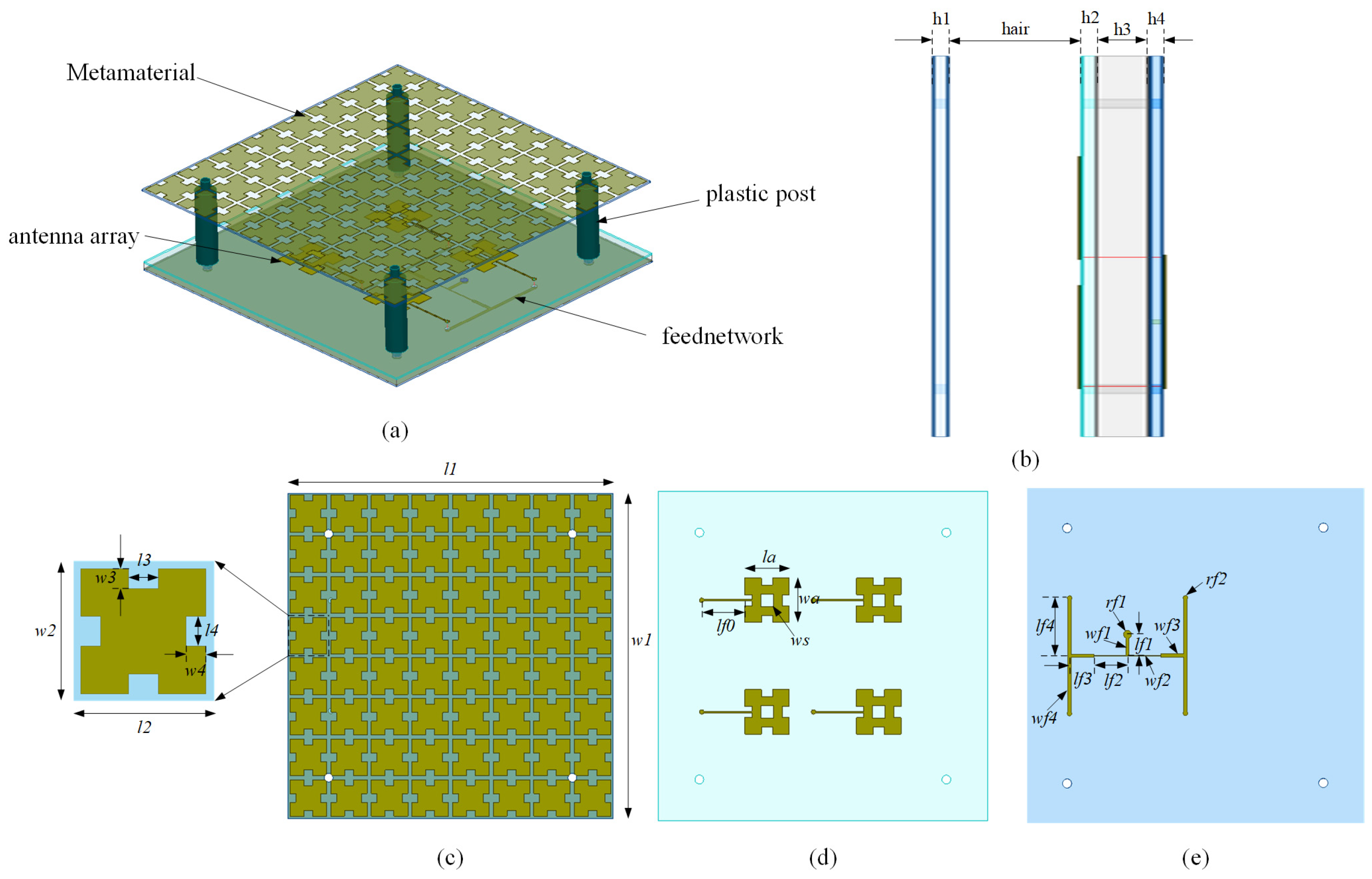
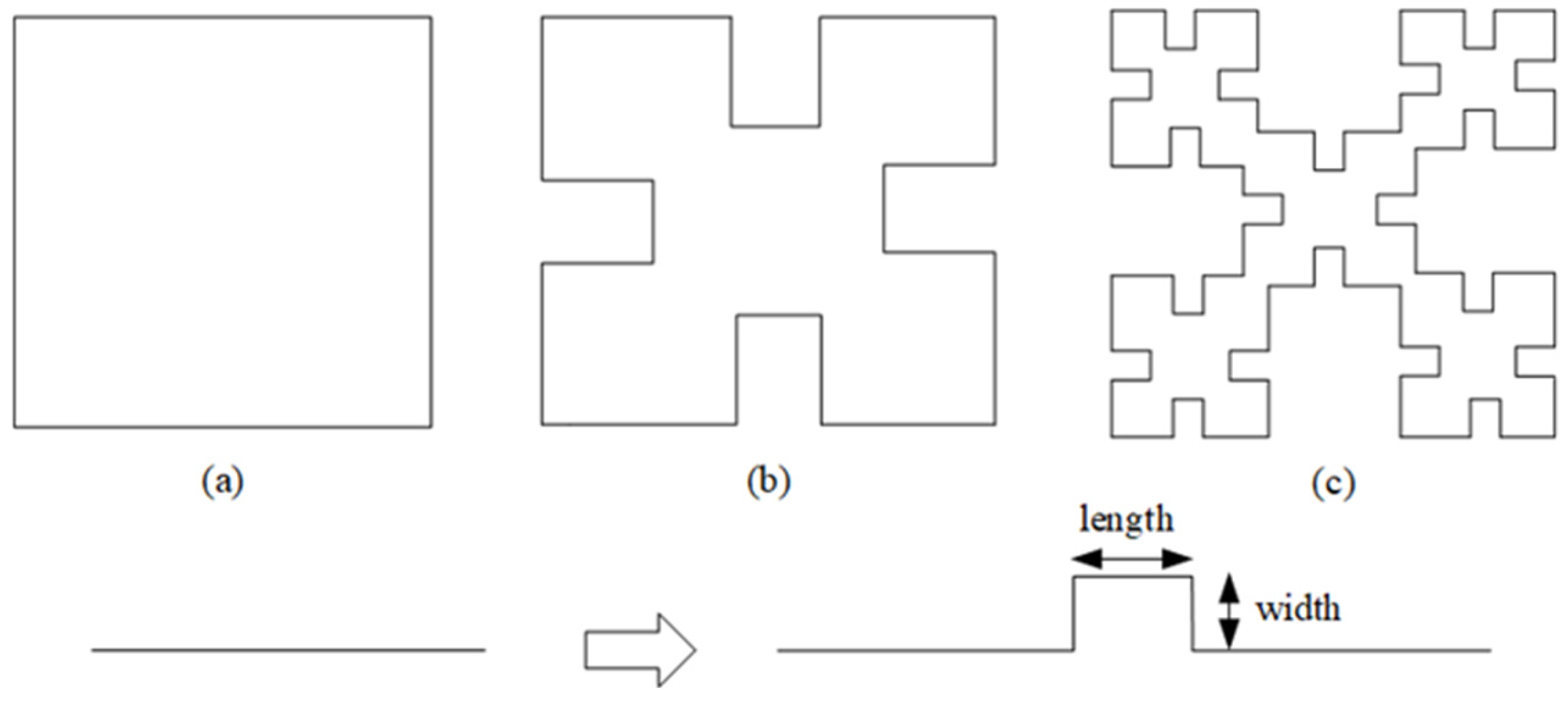

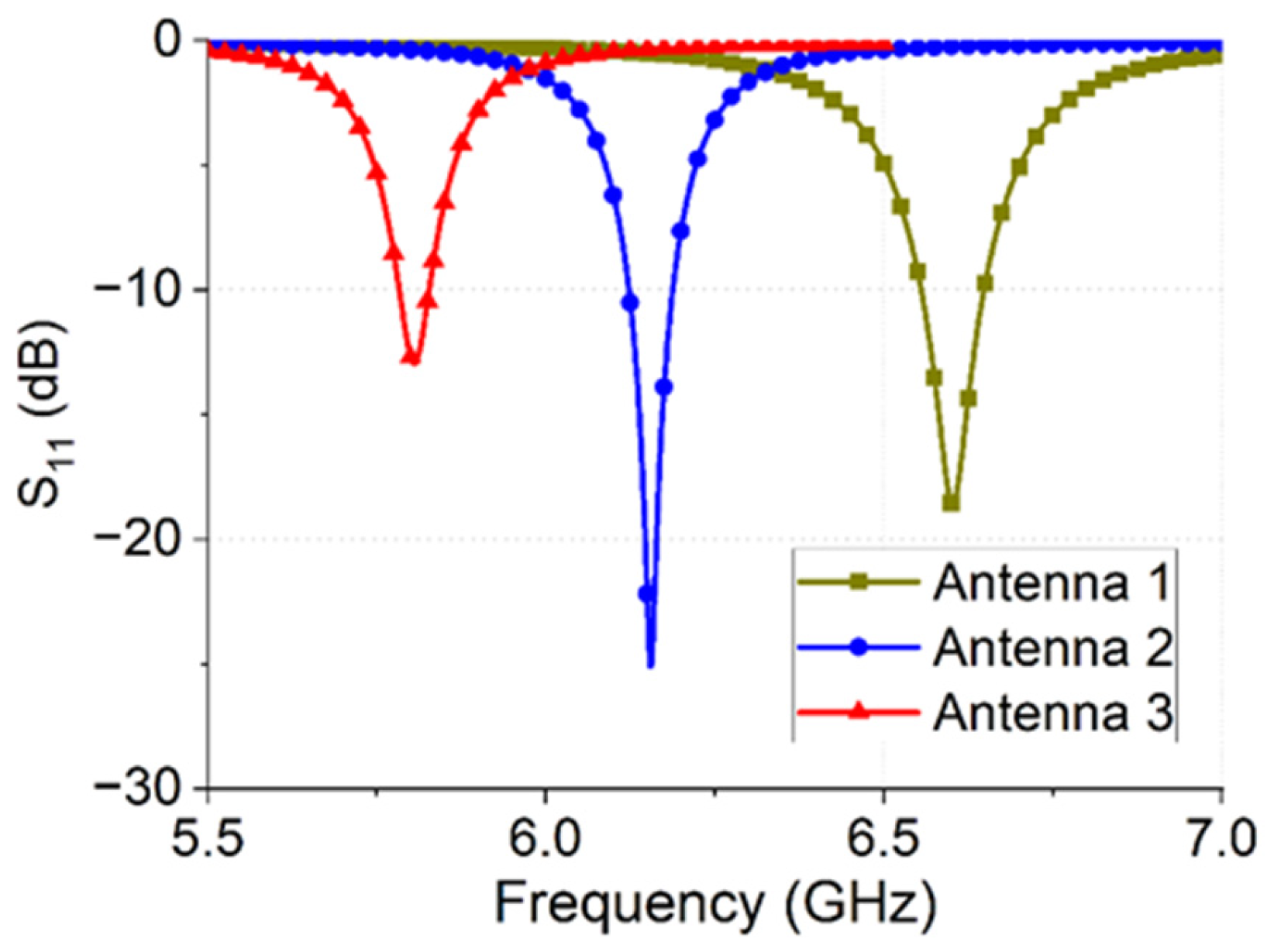

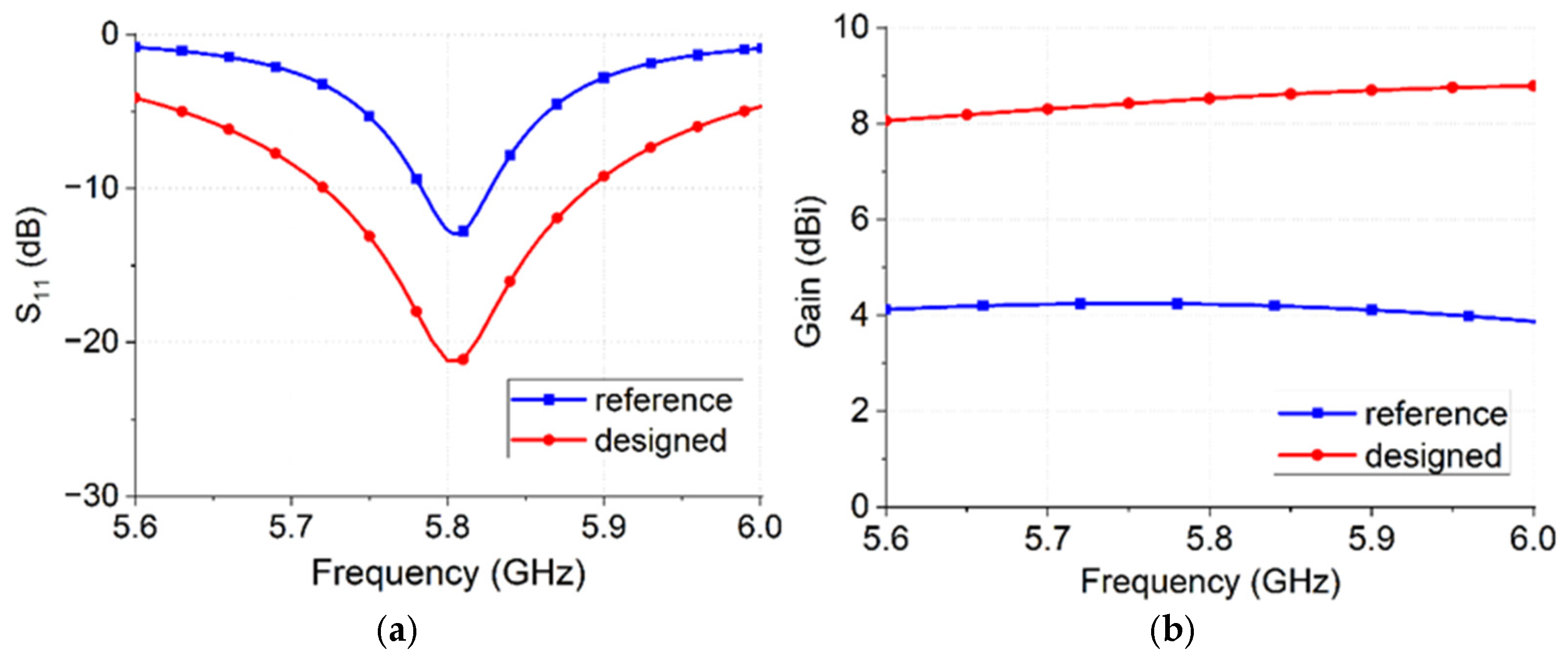
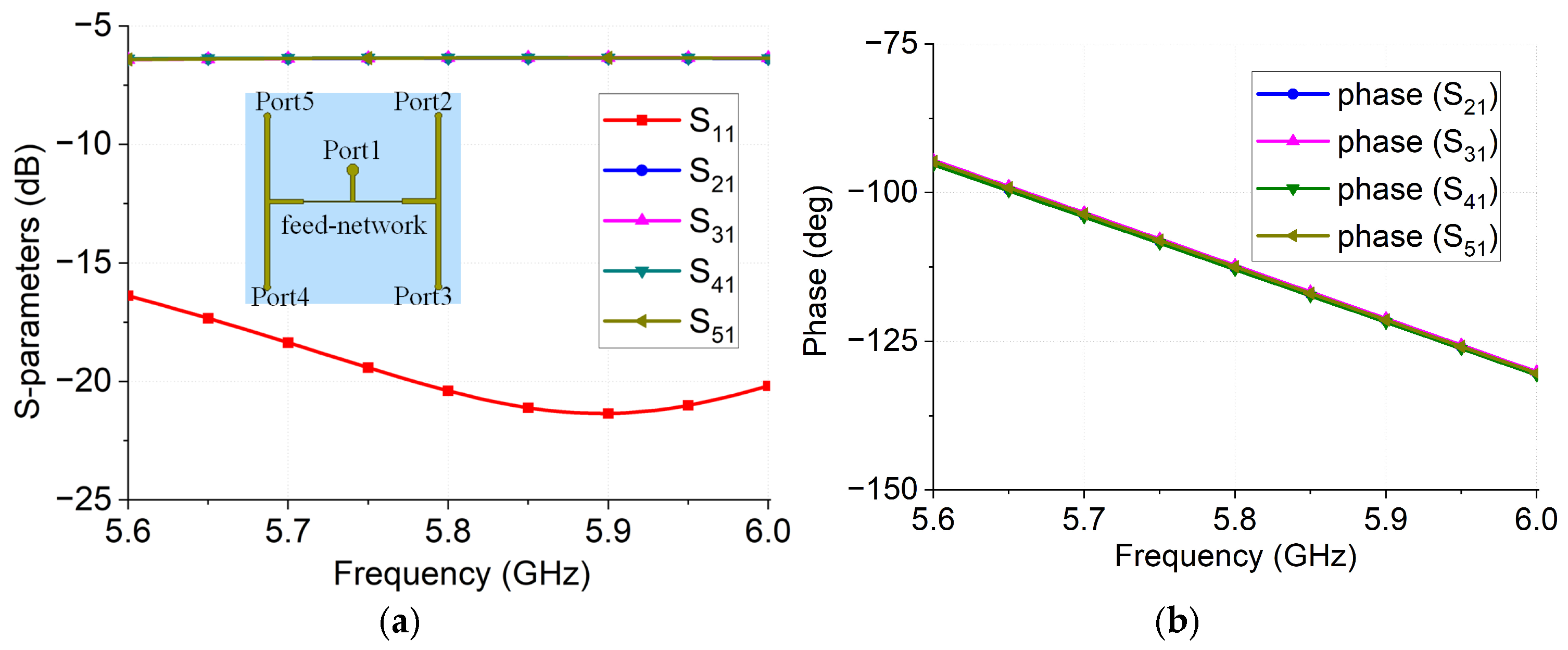
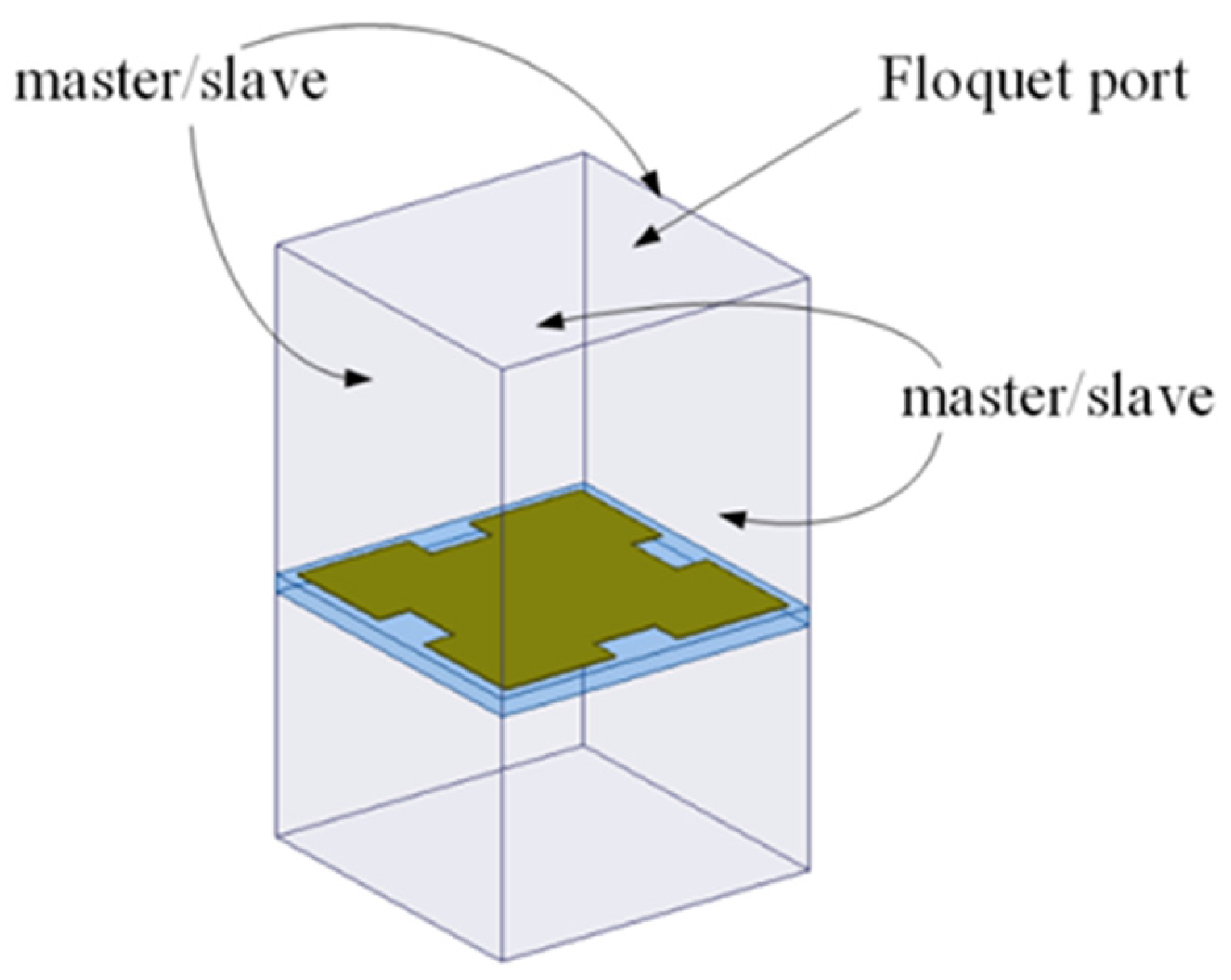

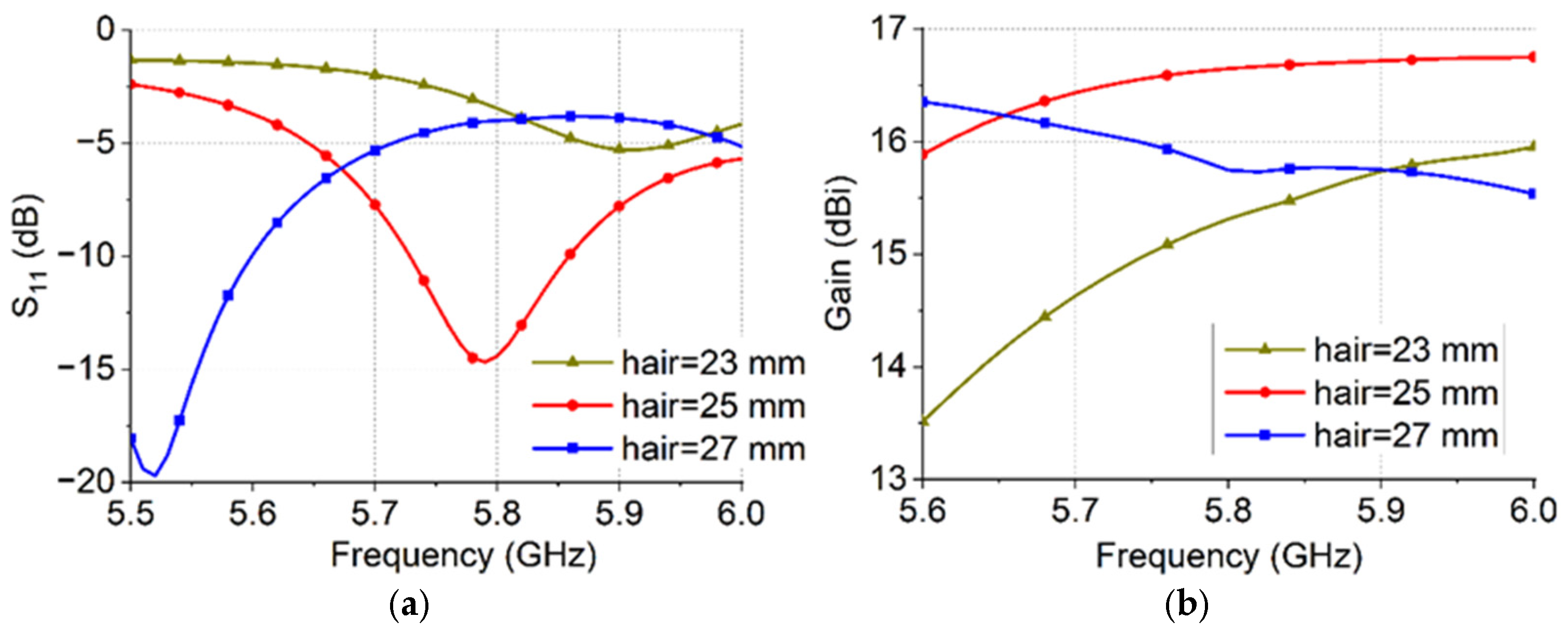

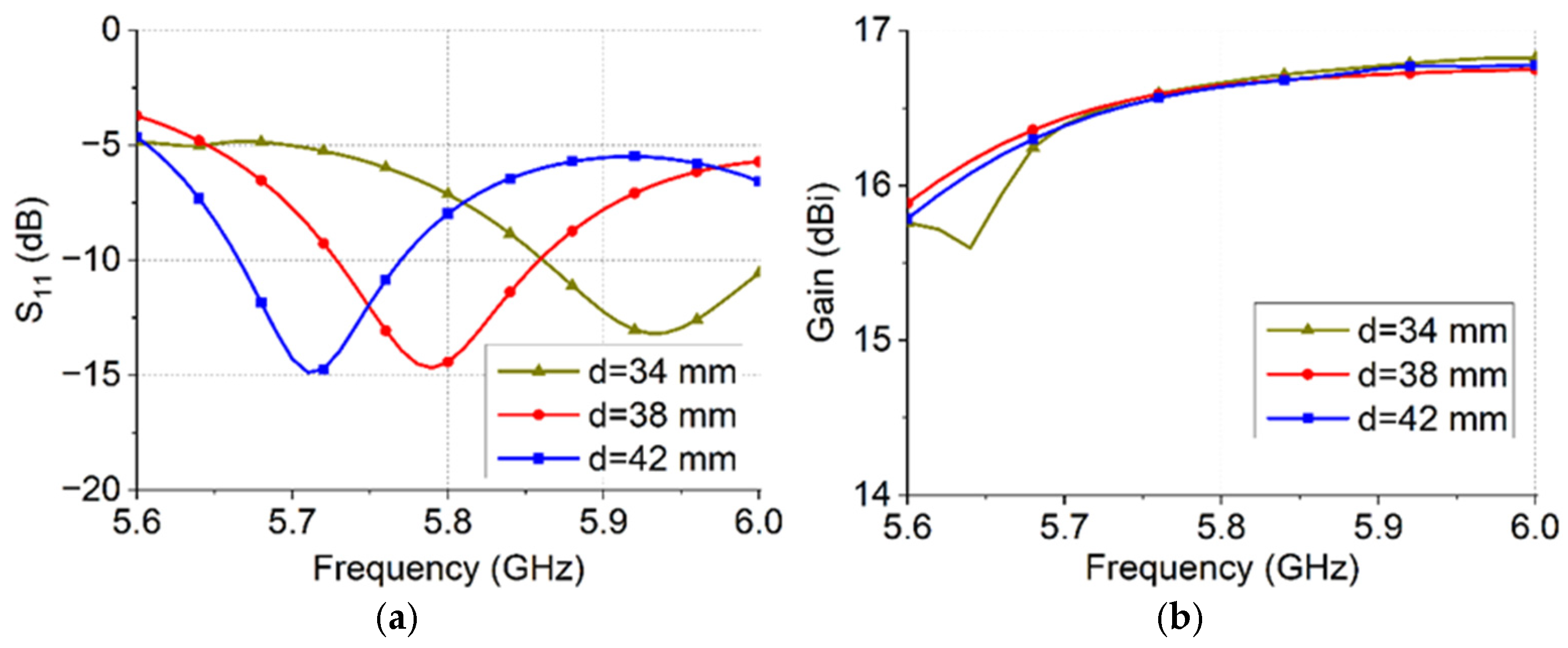
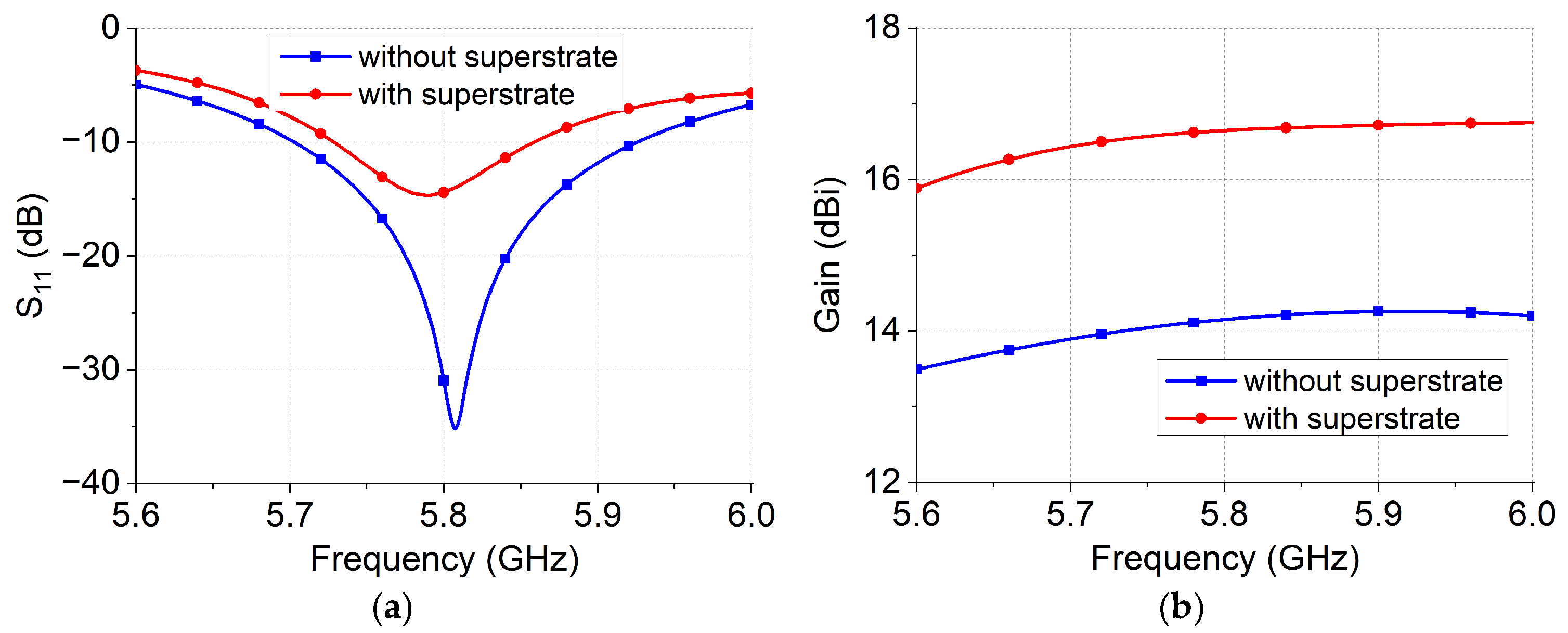
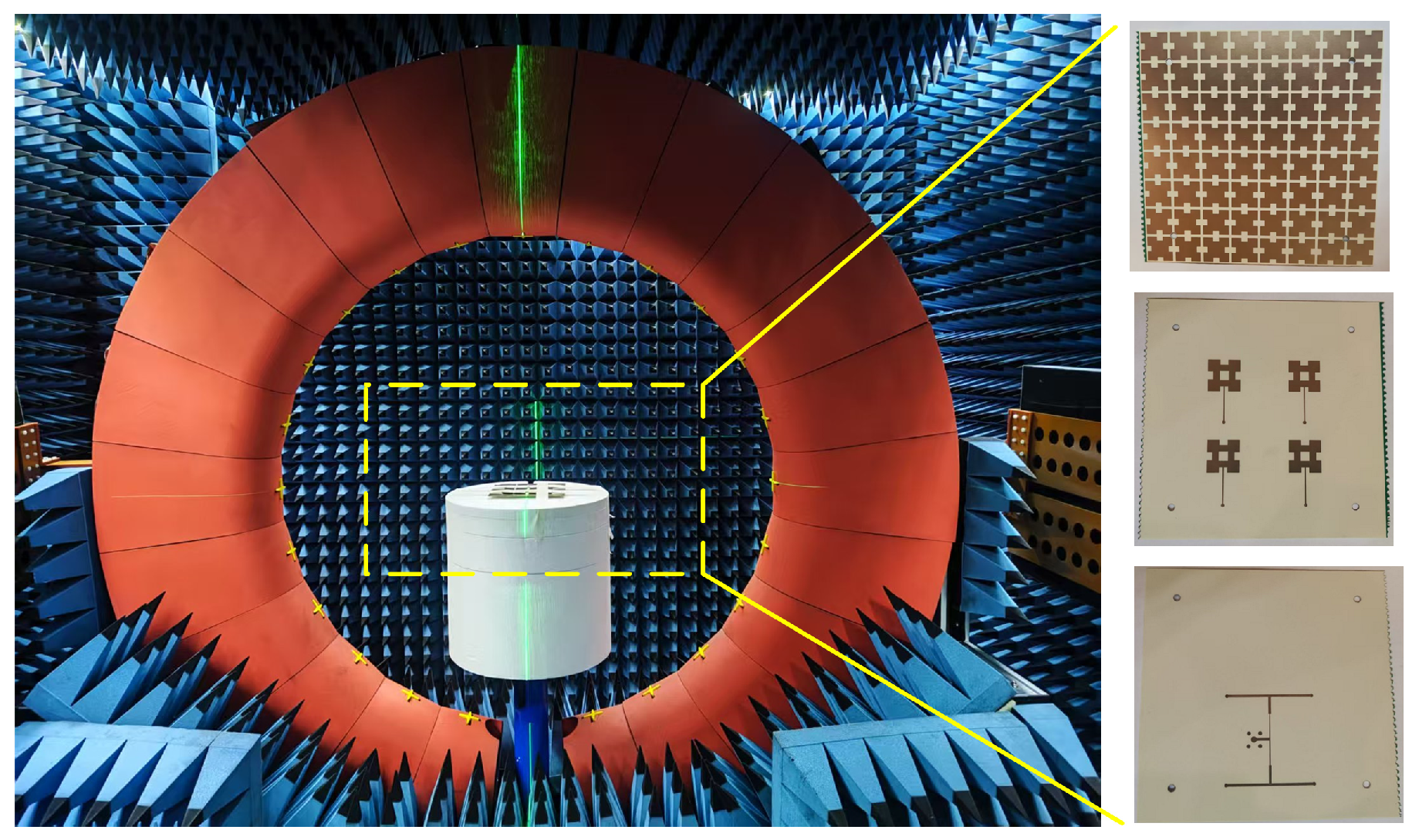


| References | Center Frequency | Antenna Structure | Size (λ03) | Bandwidth (GHz) | Gain (dBi) |
|---|---|---|---|---|---|
| [19] | 5.8 | Single layer PRS | 0.96 × 0.96 × 0.069 | 5.69–6.0 | 10.75 |
| [23] | 5.8 | Single layer PRS | 1.56 × 1.56 × 0.49 | 5.7–6.65 | 12.7 |
| [26] | 5.8 | Single layer PRS | 1.54 × 1.93 × 0.92 | 5.57–5.7 and 5.79–5.83 | 16 |
| [27] | 10.5 | Single layer PRS | 2.45 × 2.45 × 0.72 | 8.6–11.8 | 16.3 |
| [28] | 5.8 | Single layer PRS | 2.51 × 2.51 × 0.61 | 5.5–6.16 | 13.7 |
| [29] | 10 | Single layer PRS | 3.0 × 3.0 × 0.24 | 9.59–10.57 | 15.56 |
| [32] | 5.2 | Single layer PRS and HIS | 8.67 × 8.67 × 0.33 | 5.1–5.3 | 14.0 |
| [33] | 9.5 | Single layer PRS | 2.1 × 2.1 × 0.57 | 8.0–11.0 | 13.7 |
| Paper | 5.8 | Single layer PRS | 2.16 × 2.16 × 0.57 | 5.71–5.89 | 16.5 |
Disclaimer/Publisher’s Note: The statements, opinions and data contained in all publications are solely those of the individual author(s) and contributor(s) and not of MDPI and/or the editor(s). MDPI and/or the editor(s) disclaim responsibility for any injury to people or property resulting from any ideas, methods, instructions or products referred to in the content. |
© 2025 by the authors. Licensee MDPI, Basel, Switzerland. This article is an open access article distributed under the terms and conditions of the Creative Commons Attribution (CC BY) license (https://creativecommons.org/licenses/by/4.0/).
Share and Cite
Hu, W.; Peng, L.; Tang, T.; Aldhaeebi, M.A.; Almoneef, T.S. Design of High-Gain Linear Polarized Fabry–Perot Antenna Based on Minkowski Fractal Structure. Fractal Fract. 2025, 9, 685. https://doi.org/10.3390/fractalfract9110685
Hu W, Peng L, Tang T, Aldhaeebi MA, Almoneef TS. Design of High-Gain Linear Polarized Fabry–Perot Antenna Based on Minkowski Fractal Structure. Fractal and Fractional. 2025; 9(11):685. https://doi.org/10.3390/fractalfract9110685
Chicago/Turabian StyleHu, Wei, Liangfu Peng, Tao Tang, Maged A. Aldhaeebi, and Thamer S. Almoneef. 2025. "Design of High-Gain Linear Polarized Fabry–Perot Antenna Based on Minkowski Fractal Structure" Fractal and Fractional 9, no. 11: 685. https://doi.org/10.3390/fractalfract9110685
APA StyleHu, W., Peng, L., Tang, T., Aldhaeebi, M. A., & Almoneef, T. S. (2025). Design of High-Gain Linear Polarized Fabry–Perot Antenna Based on Minkowski Fractal Structure. Fractal and Fractional, 9(11), 685. https://doi.org/10.3390/fractalfract9110685








